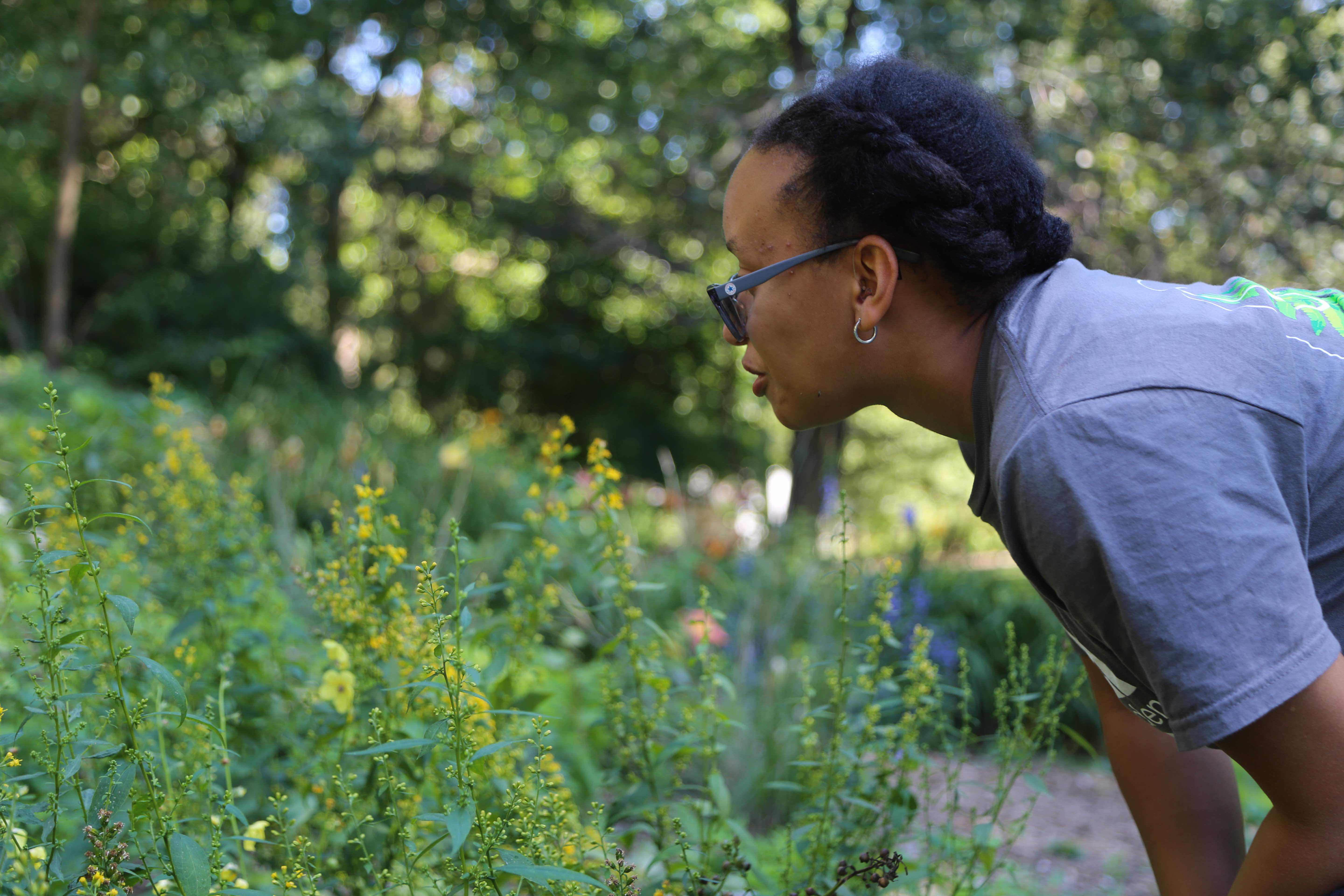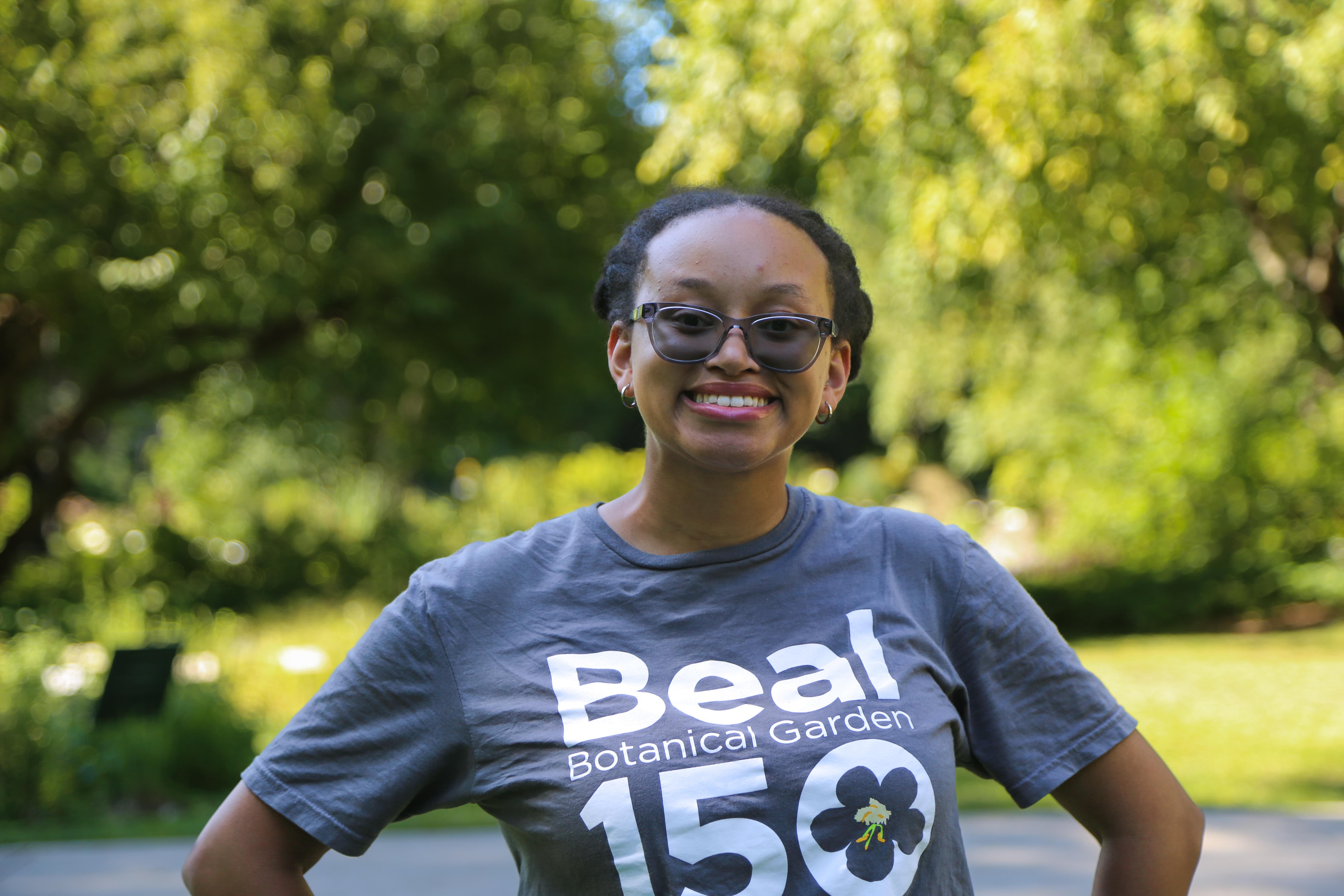When she first came to Michigan State University’s campus in the fall of 2020, Loren Campbell loved going to the Beal Botanical Garden. The beautiful campus oasis with its array of flowers, trees, birds, bees and more was the perfect spot to relax and take in nature. For the Canton, Michigan native, the garden held a special place in her heart.
So, when she got an email from her advisor about an opportunity to work in the pollinator garden as a Beal Scholar researcher, Campbell, who is majoring in entomology, jumped at the chance. Not only could she go to the garden every day for work, she thought, it also would be perfect for her studies. She was offered the position and now spends a few hours each day in the garden examining and logging the plants and pollinators like bees, wasps and flies. “It has been so fulfilling,” Campbell says of her work in the garden, “and really great for my educational and professional life.”
To Alan Prather, the interim director of the garden, Campbell’s relationship with the garden is a perfect example of the garden’s place on campus: To be a welcoming location that also provides knowledge and research opportunities — illuminating the interconnectedness between people, plants and place. That’s what the garden has been doing since it was established 150 years ago, making it the oldest continuously operated university botanical garden in the United States.
To celebrate the garden and all those who have helped it thrive those 150 years, a festival will take place at the garden Sept. 13 from 3 to 7 p.m. The occasion will honor the past as well as collectively look — with the faculty, staff, students and community that keep it running — toward the future of the Beal Botanical Garden.
Humble beginnings
The Beal Botanical Garden was officially established in 1873 near the present-day site of Beaumont Tower. It was a teaching garden with 140 species of forage grasses and clovers and, four years later in 1877, it merged with the space that famed professor William J. Beal called “the Botanic Garden,” which is where the present-day garden resides.
“When Beal established the garden on the south side of the Circle where the main garden is now,” Prather says, “he did it expressly to provide a place where native plants could be honored, maintained and grown for educational and enjoyment purposes.”
By 1905, the garden was home to about 2,300 species, many of which were nonnative plants. It remained an evolving garden, but by the 1950s, it was reorganized into its current system that houses plants based on collections like systematic (arranged by taxonomic orders and families), economic (plants that humans rely on for food, shelter or even scents and dyes) or other groupings.
Throughout the years, the garden fell under the umbrella of different departments on campus, but now is part of the Provost’s Office at MSU and operates as one of several units that comprise University Arts and Collections along with the Broad Art Museum, MSU Museum and Wharton Center for Performing Arts.
Today, with a collection of over 2,000 plants and on the list of the Michigan State Register of Historic Places, the garden is using the past 150 years as a springboard for what it hopes to do for the campus community moving forward.
The garden today and beyond
“My goal,” says Maeve Bassett, the education director of the Beal Botanical Garden, “is that anyone who walks into the garden — whether they’re a math major or a cold war assassination specialist — I can find some way to get them interested in plants.”
Bassett is not the only one who feels that way. In fact, a committee is working on a strategic plan for the Beal Botanical Garden that, according to Prather, will forge a richer relationship with the academic community on campus while also growing the teaching and research programs for the broader MSU community, which includes campus visitors.
That plan is still in the works, but things are already being done at the garden that should impact the future. The botanical garden has a lot of passive educational activities like the interactive map of the garden and Campus Arboretum, but Prather is working on ways the garden can offer more active learning and projects with faculty and instructors. He also wants the garden to be a space for the community with programs like Nurture Your Roots, which invites visitors to connect mind, body and nature with practices to enrich well-being.
Then, there’s the work to keep the garden in pristine condition and the commitment to sustainability. From the Red Cedar River Restoration project, which includes a team that removes invasive species like black swallowwort and goutweed from the riverbank, to the recently established pollinator garden in the southeastern section of the garden, the team behind the garden is making sure it lives up to its 150-year-old mission.
The pollinator garden represents that mission and then some.
A campus sanctuary
On a sunny day in late August that has a crispness in the air that seems to be warning of fall weather on the way, Loren Campbell walks through the garden and stops as a bumblebee flutters its way and lands on a zigzag goldenrod flower. She leans in and examines the insect as it extracts nectar. She will often log a bug sighting in an online database and then move on to the next plant and insect. Sometimes, if she can’t identify the bug, she will catch it, take it under a microscope to make sure she knows exactly what type of insect she’s dealing with and then release it back into the garden. But in this moment after saying there are probably around 250 species of bumblebees, she exhales and says, “I just love bugs.”
Campbell is a Beal Scholar, which is a mentored experience for undergraduate students from any discipline who are looking to gain experience in botanical garden operations and project management. She is the first pollinator garden researcher, and her work is important to the garden’s future. “Our goal in the pollinator garden,” she says, “is to attract as many native pollinators as we can — we want a big variety.” For Campbell, that means she’s trying to discover which plants will help attract a variety of pollinators throughout the spring, summer and early fall. “We’re trying to optimize the blooms of the plants in the garden,” she says.
They may even move a lakeside daisy plant, which is currently in the endangered species section of the garden, to the pollinator garden because she saw how many pollinators were attracted to it.
Campbell says that while many people just assume honeybees are what she deals with, she is focusing on all the flies and wasps and other pollinators that are native to Michigan because, she says, the honeybee is not. Campbell is hoping that the garden can be a landing spot for many native plants and pollinators. The research she’s doing is, at the very least, a start.

More than an opportunity for research, the garden happens to be one of Campbell’s favorite spots on campus, a spot of memories — just like it is for many campus visitors.
“The first time I found the botanical garden I was just amazed,” Campbell says. “I’d never seen anything like it.”
The Beal Botanical Garden is unique. Not only is it the oldest continuously operated university botanical garden in the United States and a campus hub for research and well-being, but it is also a classroom of sorts. As the garden celebrates its first 150 years, it also looks forward to its place on campus for many years to come.
As Campbell says, there isn’t anything like it.

